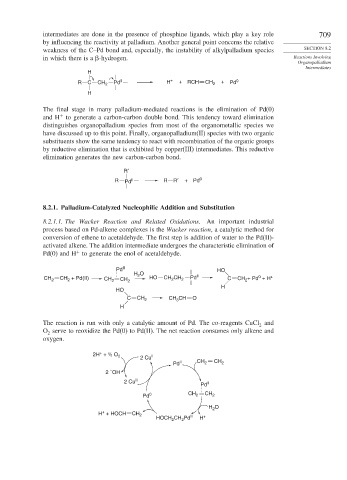Page 733 - Advanced Organic Chemistry Part B - Reactions & Synthesis
P. 733
intermediates are done in the presence of phosphine ligands, which play a key role 709
by influencing the reactivity at palladium. Another general point concerns the relative
weakness of the C–Pd bond and, especially, the instability of alkylpalladium species SECTION 8.2
in which there is a -hydrogen. Reactions Involving
Organopalladium
Intermediates
H
R C CH 2 Pd II H + + RCH CH 2 + Pd 0
H
The final stage in many palladium-mediated reactions is the elimination of Pd(0)
+
and H to generate a carbon-carbon double bond. This tendency toward elimination
distinguishes organopalladium species from most of the organometallic species we
have discussed up to this point. Finally, organopalladium(II) species with two organic
substituents show the same tendency to react with recombination of the organic groups
by reductive elimination that is exhibited by copper(III) intermediates. This reductive
elimination generates the new carbon-carbon bond.
R′
R Pd II R R′ +Pd 0
8.2.1. Palladium-Catalyzed Nucleophilic Addition and Substitution
8.2.1.1. The Wacker Reaction and Related Oxidations. An important industrial
process based on Pd-alkene complexes is the Wacker reaction, a catalytic method for
conversion of ethene to acetaldehyde. The first step is addition of water to the Pd(II)-
activated alkene. The addition intermediate undergoes the characteristic elimination of
+
Pd(0) and H to generate the enol of acetaldehyde.
Pd II HO
H O
2
0
CH 2 CH + Pd(II) CH 2 CH 2 HO CH CH 2 Pd II C CH 2 + Pd + H +
2
2
H
HO
C CH 2 CH 3 CH O
H
The reaction is run with only a catalytic amount of Pd. The co-reagents CuCl and
2
O serve to reoxidize the Pd(0) to Pd(II). The net reaction consumes only alkene and
2
oxygen.
+
2H + ½ O 2 2 Cu I
Pd II CH 2 CH 2
–
2 OH
2 Cu II II
Pd
Pd 0 CH 2 CH 2
H O
2
+
H + HOCH CH 2
HOCH CH Pd II H +
2
2

